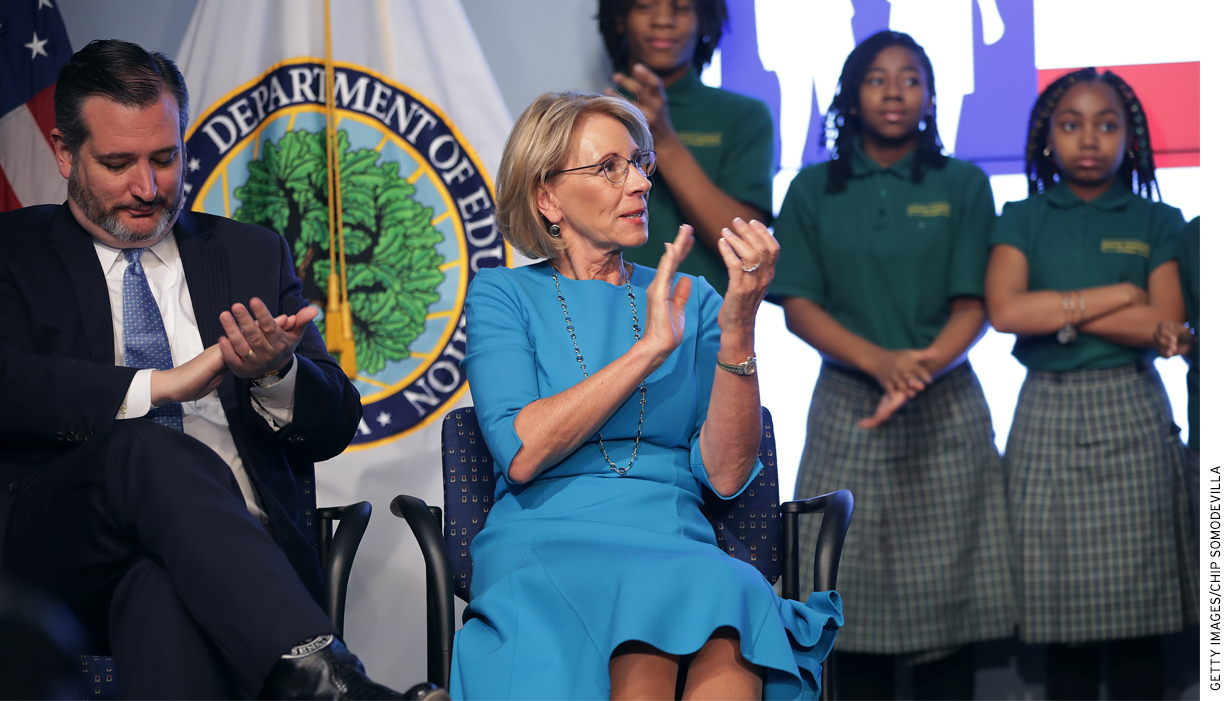
Secretary of Education Betsy DeVos, along with Sen. Ted Cruz (R-TX) and Rep. Bradley Byrne (R-AL), announced Thursday a bill to create a nationwide tax credit scholarship program that could expand school choice.
Tax credit scholarship programs are already used in 18 states to provide students with the opportunity to attend schools other than their nearest public school. These programs allow people and corporations to donate to a designated scholarship granting organization (SGO) and be reimbursed in the form of a tax credit. In Cruz and Byrne’s plan, states would designate the eligible SGOs, but the federal government would fund the tax credit reimbursement, up to $5 billion total.
Currently, tax credit scholarships are used primarily to allow students, often from low-income families, to attend tuition-charging private schools. The new Education Freedom Scholarships proposal would allow state-selected SGOs to provide the scholarships for any program designed to increase students’ opportunities through school choice. These programs could be private school scholarships, but they could also be supplemental tutoring, career and technical education, or transportation.
In light of the announcement, we offer four important takeaways from our research on school choice for policymakers considering the program.
1. Recent research on private school choice programs shows limited effects on achievement but positive effects on college enrollment.
In recent studies of school voucher programs in Louisiana and Indiana, researchers found that students who switched from public to private school through a voucher program lost ground in the first few years, as measured by test scores. But a series of Urban Institute papers, including a report on Florida’s tax credit scholarship program released last month, found that participating in private school choice usually increased the rate at which students went to and graduated from college. The DC Opportunity Scholarship Program offers the one exception, as students in this program were no more or less likely to go to college. They were, however, more likely to graduate high school, and parents reported higher levels of satisfaction.
2. Geography matters.
Whether private school choice, public school choice, or transportation investments would make the most sense will depend heavily on the state’s educational landscape and on where students live.
In a 2017 report, we looked at which families would actually get more options under various school choice policies. We found, not surprisingly, that urban families were more likely than rural families to live within easy commuting distance of a private school, charter school, or at least two within-district traditional public schools. Families below the federal poverty level are more likely to live near multiple within-district traditional public schools, a charter school, or a private school than families above the federal poverty level.
Population density, district boundaries, and political preferences will all be important considerations for states that choose to use the tax credit scholarship, should the program become law. Private school choice might not be politically viable in Massachusetts, for example, even though 95 percent of elementary school students live near a private school.
In other states, district size makes some forms of school choice more viable than others. Nevada has large districts, so few students can easily access schools outside their home district, but Vermont has small districts, meaning few students have additional public school options within their own district. The key here is that what works in one state might not work in another.
3. Transportation can be a barrier to choice.
In cities with substantial school choice, we have found that black students typically travel farther than white students to school, and that, relative to driving, taking public transit can easily double or triple the time it takes to get to school. Traveling to a more distant but preferred school can bring costs for both students and their families. States could, however, use these funds to subsidize transportation to nonneighborhood schools. Some states already do this.
The Minnesota K–12 Education Credit allows parents to claim transportation costs paid to others for a student’s transportation during the school day. Transportation to nonneighborhood schools—whether it’s to traditional public schools within or outside the student’s home district or to private or charter schools—could open up new opportunities for low-income families.
4. School choice policies might work against desegregation efforts.
A recent analysis of New York City’s centralized high school choice policy found that parents prefer schools with high-achieving peers over schools that are more effective at raising student test scores. As a result, expanding school choice could lead to intense competition for spaces at popular schools and increased segregation by race and class. But the proposed tax credit scholarship program could be used to support desegregation efforts, such as scholarships that enable low-income students to go to school in a neighboring district or targeted transportation subsidies aimed at increasing socioeconomic integration.
A federal tax credit scholarship program could provide states with a new funding source to expand educational opportunities for the most vulnerable students. But there is no one-size-fits-all approach, and for the program to be successful, states will need to begin with a thorough review of the evidence.
Kristin Blagg is a research associate in the Income and Benefits Policy Center at the Urban Institute. Matthew M. Chingos is director of the Urban Institute’s Education Policy Program. Tomas Monarrez is a research associate at the Urban Institute’s Center on Education Data and Policy. Alexandra Tilsley manages communications and outreach for the Urban Institute’s Center on Education Data and Policy.
This post originally appeared on Urban Wire.


